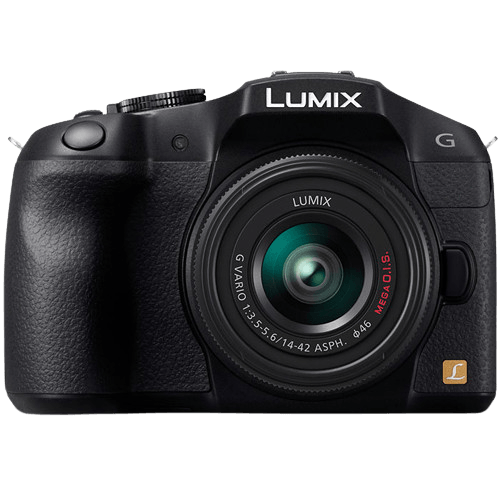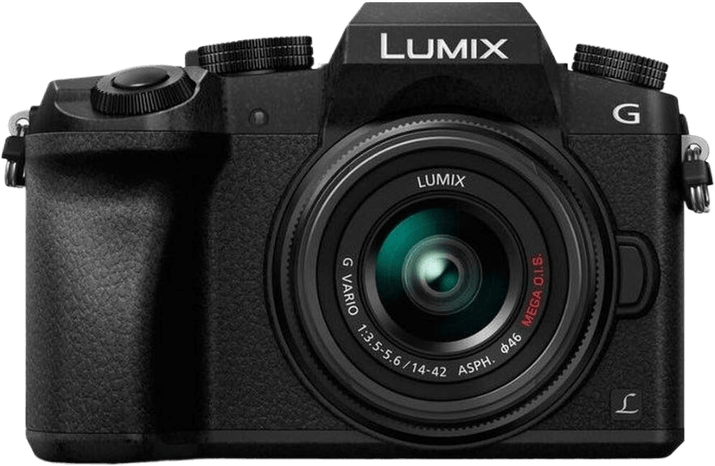Panasonic Lumix DMC-G6 vs Lumix DMC-G7 Comparison
Panasonic Lumix DMC-G6

Panasonic Lumix DMC-G7

The Panasonic Lumix DMC-G7 comes out ahead with a score of 52/100, while the Panasonic Lumix DMC-G6 trails behind at 48/100. Both cameras share similarities such as being mirrorless and having a similar launch price ($750 for the G6 and $799 for the G7). However, the G7’s higher score can be attributed to its more recent release year (2015) compared to the G6’s 2013 release.
The G7 is slightly larger and heavier, measuring 125 x 86 x 77mm and weighing 410g, compared to the G6’s 122 x 85 x 71mm and 390g. While the G6 is more compact and lightweight, the G7’s improved performance and features make it the better option. In the end, the choice between these two cameras comes down to individual preferences and priorities.
Panasonic Lumix DMC-G6 vs Lumix DMC-G7 Overview and Optics
The Panasonic Lumix DMC-G7 outperforms the DMC-G6 in optics, scoring 51/100 compared to the G6’s 47/100. Both cameras share several specifications, including 16-megapixel resolution, 7 fps shooting speed, CMOS sensor type, Micro Four Thirds sensor size, Micro 4/3 lens mount, and lack of image stabilization.
The G7’s superior performance is due to its higher DXOMARK sensor score of 75, compared to the G6’s 61. This difference indicates that the G7 has better image quality and low-light performance. The G7 also has an unspecified processor, which might contribute to its improved optics performance.
The G6, on the other hand, features a Venus Engine IX processor. While this processor is not as advanced as the one in the G7, it still enables the G6 to capture high-quality images with good color reproduction and sharpness. The G6’s optics are not significantly inferior to the G7’s, but the difference in DXOMARK scores does give the G7 a noticeable advantage.
In terms of optics, the Panasonic Lumix DMC-G7 is the better choice between the two cameras. Its higher DXOMARK sensor score translates to better image quality and low-light performance. The G6, while still capable of producing quality images, falls short in comparison to the G7. For those seeking superior optics performance, the G7 is the clear winner.
Panasonic Lumix DMC-G6 vs Lumix DMC-G7 Video Performance
The Panasonic Lumix DMC-G7 outperforms the Panasonic Lumix DMC-G6 in terms of video capabilities, scoring 83/100 compared to the G6’s 56/100. Both cameras share some common specifications, such as a maximum video frame rate of 60fps. However, the G7 possesses superior features that give it an edge over the G6.
One major advantage of the G7 is its 4K video resolution, which provides significantly better video quality than the G6’s Full HD resolution. The G7’s maximum video dimensions are 3840 x 2160, while the G6 only offers 1920 x 1080. This difference in resolution and dimensions allows the G7 to capture more detail and produce sharper videos.
Another notable feature of the G7 is its built-in time-lapse functionality. This capability enables users to create time-lapse videos easily without the need for additional equipment or software. The G6, unfortunately, does not have this feature.
The G6 does not have any specific advantages over the G7 when it comes to video capabilities. The G7’s higher score reflects its superior performance and features in this area.
Considering the differences in video capabilities between the Panasonic Lumix DMC-G7 and DMC-G6, it is clear that the G7 is the better choice for those who prioritize video quality and functionality. Its 4K resolution and built-in time-lapse functionality make it a more versatile and powerful option for videographers.
Panasonic Lumix DMC-G6 vs Lumix DMC-G7 Features and Benefits
The Panasonic Lumix DMC-G7 emerges as the winner in this comparison, scoring 58 out of 100 points, while the Panasonic Lumix DMC-G6 scores 57 points. Both cameras share several features, including a 3-inch touchscreen, flip screen, Wi-Fi connectivity, and the lack of GPS and Bluetooth.
The Lumix DMC-G7 has a significant advantage in screen resolution, with 2,360,000 dots compared to the Lumix DMC-G6’s 1,036,000 dots. This higher resolution offers a clearer and sharper display, improving user experience when reviewing images or navigating menus.
On the other hand, the Lumix DMC-G6 does not have any standout advantages over the Lumix DMC-G7. The one-point difference in the feature score is not enough to make up for the G7’s superior screen resolution. Thus, the Lumix DMC-G7 remains the better choice in terms of features.
Considering the similar feature scores and shared specifications, both cameras are quite similar in terms of functionality. However, the Lumix DMC-G7’s higher screen resolution gives it a slight edge over the Lumix DMC-G6. Users who prioritize a better display experience should opt for the Lumix DMC-G7, while those who find the one-point difference in feature score negligible can choose either camera without a significant loss in overall performance.
Panasonic Lumix DMC-G6 vs Lumix DMC-G7 Storage and Battery
The Panasonic Lumix DMC-G7 wins in the storage and battery category with a score of 35/100, compared to the Panasonic Lumix DMC-G6’s score of 21/100. Both cameras have one memory card slot, accepting SD, SDHC, and SDXC cards. They also share the same battery type, DMW-BLC12.
The G7 has a slightly longer battery life, providing 350 shots per charge, while the G6 offers 340 shots. This difference gives the G7 a slight advantage in this aspect. Additionally, the G7 supports USB charging, making it more convenient for users who need to charge their camera on the go.
The G6 has no particular advantages over the G7 in terms of storage and battery. Therefore, the G7 proves to be a better choice for those prioritizing battery life and charging convenience. The higher score of the G7 reflects its superiority in this category, making it a more appealing option for potential buyers.
Panasonic Lumix DMC-G6 vs Lumix DMC-G7 – Our Verdict
Are you still undecided about which camera is right for you? Have a look at these popular comparisons that feature the Panasonic Lumix DMC-G6 or the Panasonic Lumix DMC-G7:

